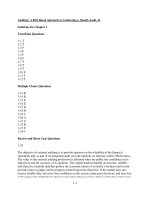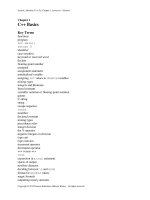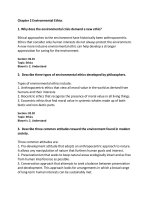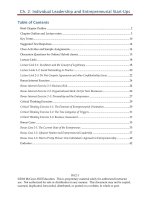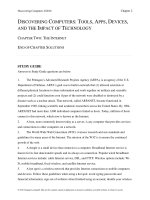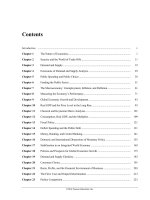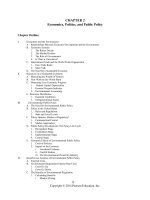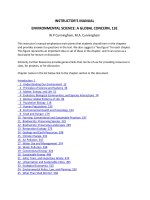Test bank and solution manual of discovering computer tools apps devices ch02 (1)
Bạn đang xem bản rút gọn của tài liệu. Xem và tải ngay bản đầy đủ của tài liệu tại đây (162.56 KB, 12 trang )
Discovering Computers ©2016
Chapter 2
DISCOVERING COMPUTERS: TOOLS, APPS, DEVICES,
AND THE IMPACT OF TECHNOLOGY
CHAPTER TWO: THE INTERNET
END OF CHAPTER SOLUTIONS
STUDY GUIDE
Answers to Study Guide questions are below.
1.
The Pentagon’s Advanced Research Projects Agency (ARPA), is an agency of the U.S.
Department of Defense. ARPA’s goal was to build a network that (1) allowed scientists at
different physical locations to share information and work together on military and scientific
projects and (2) could function even if part of the network were disabled or destroyed by a
disaster such as a nuclear attack. That network, called ARPANET, became functional in
September 1969, linking scientific and academic researchers across the United States. By 1984,
ARPANET had more than 1,000 individual computers linked as hosts. Today, millions of hosts
connect to this network, which now is known as the Internet.
2.
A host, more commonly known today as a server, is any computer that provides services
and connections to other computers on a network.
3.
The World Wide Web Consortium (W3C) oversees research and sets standards and
guidelines for many areas of the Internet. The mission of the W3C is to ensure the continued
growth of the web.
4.
A dongle is a small device that connects to a computer. Broadband Internet service is
known for its fast data transfer speeds and its always-on connection. Popular wired broadband
Internet services include: cable Internet service, DSL, and FTTP. Wireless options include: WiFi, mobile broadband, fixed wireless, and satellite Internet service.
5.
A hot spot is a wireless network that provides Internet connections to mobile computers
and devices. Follow these guidelines when using a hot spot: avoid typing passwords and
financial information; sign out of websites when finished using an account; disable your wireless
© 2016 Cengage Learning®. May not be scanned, copied or duplicated, or posted to a publicly accessible website, in whole or in part.
Discovering Computers ©2016
Chapter 2
connection when not needed; do not leave your computer or mobile device unattended; and
beware of over-the-shoulder snoopers.
6.
ISP stands for Internet service provider.
7.
Computers and devices connected to the Internet work together to transfer data around
the world using servers and clients and various wired and wireless transmission media. On the
Internet, your computer or device is a client that can access data and services on a variety of
servers. Several main transmission media carry the heaviest amount of traffic, or
communications activity, on the Internet. These major carriers of network traffic are known
collectively as the Internet backbone.
8.
An IP address is a sequence of numbers that uniquely identifies the location of each
computer or device connected to the Internet. Due to the growth of the Internet, the original IPv4
addresses began dwindling in availability. The IPv6 scheme increased the available number of IP
addresses exponentially.
9.
A domain name is a text-based name that corresponds to the IP address of a server that
hosts a website. To register for a domain name: run a browser; use a search engine to locate a
domain name registrar and then navigate to the website; perform a search on the domain name
registrar’s website for the domain name you wish to register; follow the steps on the domain
name registrar’s website to select and complete the purchase and registration of the desired
domain name.
10.
Some generic TLDs and their purposes include: .com (commercial organizations,
businesses, and companies); .edu (educational institutions); .gov (government agencies); .mil
(military organizations); .net (network providers or commercial companies); and .org (nonprofit
organizations. The organization that approves and controls TLDs is called ICANN, which stands
for Internet Corporation for Assigned Names and Numbers.
11.
Cybersquatters purchase unused or lapsed domain names so that they can profit from
selling them. Cybersquatters sometimes will sell you the domain name, but some take advantage
of people trying to reach a more popular website to promote their own business or needs.
Cybersquatters look for out-of-date registrations and buy them so that the original website owner
must buy them back. Cybersquatters often purchase domain names with common words,
alternate spellings of trademarked terms, or celebrity names.
© 2016 Cengage Learning®. May not be scanned, copied or duplicated, or posted to a publicly accessible website, in whole or in part.
Discovering Computers ©2016
12.
Chapter 2
When you enter a domain name in a browser, a DNS server translates the domain name
to its associated IP address so that the request can be routed to the correct computer.
13.
Visitors to a static webpage all see the same content each time they view the webpage.
With a dynamic webpage, by contrast, the content of the webpage generates each time a user
displays it.
14.
The web consists of a worldwide collection of electronic documents. Each electronic
document on the web is called a webpage, which can contain text, graphics, animation, audio,
and video. A website is a collection of related webpages and associated items, such as documents
and photos, stored on a web server. A web server is a computer that delivers requested webpages
to your computer or mobile device.
15.
A browser is an application that enables users with an Internet connection to access and
view webpages on a computer or mobile device. Current browsers typically support tabbed
browsing, where the top of the browser shows a tab (similar to a file folder tab) for each
webpage you display.
16.
Follow these guidelines when browsing: verify the website is safe; turn off location
sharing; clear your browsing history; never store passwords; use a phishing filter; enable a popup blocker; use private browsing; and use a proxy server.
17.
Popular browsers include: Chrome, Firefox, Internet Explorer, Opera, and Safari.
18.
A webpage has a unique address, called a web address or URL (Uniform Resource
Locator).
19.
A web address consists of a protocol (http://), domain name (nps.gov), and sometimes the
host name (www.), path to a specific webpage (/history), or file name of the webpage
(/places.htm).
20.
A web feed contains content that has changed on a website.
21.
A web app is an application stored on a web server that you access through a browser. A
mobile app is an application you download from a mobile device’s app store or other location on
the Internet to a smartphone or other mobile device. Web apps and mobile apps often work
together. Because the data and information for each app is stored on cloud storage, all data is
synchronized and accessible from anywhere you have an Internet connection, regardless of the
computer or device used. The functionality of the app across computers and devices generally is
the same, although the mobile app sometimes has fewer features.
© 2016 Cengage Learning®. May not be scanned, copied or duplicated, or posted to a publicly accessible website, in whole or in part.
Discovering Computers ©2016
22.
Chapter 2
A GPS receiver is a handheld, mountable, or embedded device that contains an antenna, a
radio receiver, and a processor. Most smartphones include embedded GPS receivers so that users
can determine their location, obtain directions, and locate points of interest.
23.
Apps can transmit your location, as well as the time you spend using the app. Apps also
can collect personal information, including gender and birth year, if you access the app through
an online social network profile. Some track user data without permission, or require you to
enable tracking before you can use the app. Other apps may track your location without your
knowledge, such as apps that parents use to pinpoint a child’s whereabouts. If you search for
driving directions, coupons, or restaurant tips based on your current location or past activities,
you might be using apps that openly use this type of tracking. When people use location-tracking
apps, for instance, they run the risk of someone stalking or robbing them. One positive use of
location-tracking apps is with emergency services. Lawmakers have struggled with whether law
enforcement officials can use location-tracking without a user’s knowledge.
24.
A web search engine is software that finds websites, webpages, images, videos, news,
maps, and other information related to a specific topic. You also can use a search engine to solve
mathematical equations, define words, and more. Search engines require that you enter a word or
phrase, called search text, to describe the item you want to find. To improve your searches: use
specific nouns, put the most important terms first in the search text, list all possible spellings,
before using a search engine, read its Help information, and if the search is unsuccessful with
one search engine, try another
25.
Besides webpages, a search engine can find: images, videos, maps, audio, publications,
people or businesses, and blogs.
26.
A search engine lists a sequence of search results. The content of the search results varies
depending on the type of information you are seeking and your search text. A subject directory
classifies webpages in an organized set of categories, such as sports or shopping, and related
subcategories.
27.
Personal uses of online social networks include sharing photos and videos, greetings, or
status updates. You can like, or show appreciation for, online content such as photos or videos on
online social networks. Businesses use online social networks to connect with their customers,
provide promotional offers, and offer targeted advertising. Businesses also use data from online
social networks to better connect with and understand customers.
© 2016 Cengage Learning®. May not be scanned, copied or duplicated, or posted to a publicly accessible website, in whole or in part.
Discovering Computers ©2016
28.
Chapter 2
To use online social networks securely: during the registration process, provide only
necessary information; manage your profile and check for privacy settings; choose friends
carefully; limit friends; divulge only relevant information; be leery of urgent requests for help;
and read the privacy policy.
29.
An informational and research website contains factual information, such as libraries,
encyclopedias, dictionaries, directories, and guides. A media sharing site is a website that
enables members to manage and share media such as photos, videos, and music. A bookmarking
site is a website that enables members to organize, tag, and share links to media and other online
content. News, weather, sports, and other mass media websites contain newsworthy material. An
educational website offers exciting, challenging avenues for formal and informal teaching and
learning. A business website contains content that increases brand awareness, provides company
background or other information, and/or promotes or sells products or services. A blog is an
informal website consisting of time-stamped articles, or posts, in a diary or journal format,
usually listed in reverse chronological order. A wiki is a type of collaborative website that allows
users to create, add, modify, or delete the website content via a browser. Many websites provide
up-to-date medical, fitness, nutrition, or exercise information for public access; some offer users
the capability of listening to health-related seminars and discussions. Several websites contain
information about space exploration, astronomy, physics, earth sciences, microgravity, robotics,
and other branches of science; scientists use online social networks to collaborate on the web. An
entertainment website offers music, videos, shows, performances, events, sports, games, and
more in an interactive and engaging environment. Online banking and online trading enable
users to access their financial records from anywhere in the world, as long as they have an
Internet connection. Travel and tourism websites enable users to research travel options and
make travel arrangements. Several mapping website and web apps exist that enable you to
display up-to-date maps by searching for an address, postal code, phone number, or point of
interest (such as an airport, lodging, or historical site). You can purchase just about any product
or service on the web, a process that sometimes is called e-retail; with an online auction, users
bid on an item being sold by someone else. Job search websites list thousands of openings in
hundreds of fields, companies, and locations. E-commerce is a business transaction that occurs
over an electronic network, such as the Internet. A portal is a website that offers a variety of
Internet services from a single, convenient location. A content aggregation website or web app,
© 2016 Cengage Learning®. May not be scanned, copied or duplicated, or posted to a publicly accessible website, in whole or in part.
Discovering Computers ©2016
Chapter 2
sometimes called a curation website, allows users to collect and compile content from a variety
of websites about a particular topic or theme. Web creation and management sites provide tools
that support the steps in creating and publishing websites
30.
Many argue that it is harmless to protect your anonymity by using a fake name but
believe that it is not right to create a fake profile to mislead others or leave malicious comments
on a website. Although some argue that creating a fake account constitutes identity theft, unless
the intent is to harm or embarrass the real person, it is not unethical or illegal. To protect yourself
from identity theft: do not tap or click links in or reply to spam; install a personal firewall; clear
or disable web cookies; turn off file and printer sharing on your Internet connection; set up a free
email account to use for merchant forms; sign up for email filtering; shred financial documents
before you discard them; provide only the required information on website forms; avoid
checking your email or performing banking activities on public computers; request a free copy of
your medical records; obtain your credit report once a year; request to be removed from mailing
lists; place your phone number on the National Do Not Call Registry; avoid shopping club and
buyer cards; do not write your phone number on charge or credit receipts; do not preprint your
phone number or Social Security Number on personal checks; fill in only the required
information on rebate, warranty, and registration forms; and block your phone number from
displaying on the receiver’s system.
31.
A tag is a short descriptive label that you assign to webpages, photos, videos, blog posts,
email messages, and other digital content so that it is easier locate at a later time. Many websites
and web apps support tagging, which enables users to organize their online content. List steps to
tag digital content. When tagging digital content: apply tags to all digital media, such as photos,
music, and videos; separate tags with a separator; choose tags that are descriptive of the content
you are posting; after you have tagged the digital content, perform a search on the media sharing
site for your content, using the tags as your search criteria, to verify your content is displayed as
intended.
32.
E-commerce is a business transaction that occurs over an electronic network, such as the
Internet. Business-to-consumer (B2C) e-commerce consists of the sale of goods and services to
the general public, such as at a shopping website. Consumer-to-consumer (C2C) e-commerce
occurs when one consumer sells directly to another, such as in an online auction. Business-tobusiness (B2B) e-commerce occurs when businesses provide goods and services to other
© 2016 Cengage Learning®. May not be scanned, copied or duplicated, or posted to a publicly accessible website, in whole or in part.
Discovering Computers ©2016
Chapter 2
businesses, such as online advertising, recruiting, credit, sales, market research, technical
support, and training.
33.
A content aggregation website or web app, sometimes called a curation website, allows
users to collect and compile content from a variety of websites about a particular topic or theme.
Types of content that may be compiled includes news, reviews, images, videos, podcasts and
blogs. Content aggregation websites save users time because they need to visit only the content
aggregation website instead of visiting multiple websites to obtain information
34.
1. Plan the website: Identify the purpose, visitors, distinguishing factors, navigation, and
domain name. 2. Design the website: appearance, layout, colors, formats, and content. 3. Create
the website using a word processing program, a content management system, website authoring
software, a text editor, or specialized website management software. 4. Host the website using: a
web hosting service, or an online content management system. 5. Maintain the website: ensure
its contents are current and all links work properly, test user satisfaction and solicit feedback, and
run analytics.
35.
The responsive web design approach adapts the layout of the website to fit the screen on
which it is displayed.
36.
When evaluating a website’s content, consider its: affiliation, audience, authority,
content, currency, design, and objectivity.
37.
Multimedia refers to any application that combines text with media.
38.
Many webpages use colorful graphics to convey messages. Many webpages use
animation, which is the appearance of motion created by displaying a series of still images in
sequence. Audio includes music, speech, or any other sound. Video consists of images displayed
in motion. Most video also has accompanying audio. You also can upload, share, or view video
clips at a video sharing site. Virtual reality (VR) is the use of computers to simulate a real or
imagined environment that appears as a three-dimensional (3-D) space. A plug-in, or add-on, is a
program that extends the capability of a browser.
39.
. A thumbnail is a small version of a larger image. An infographic (short for information
graphic) is a visual representation of data or information, designed to communicate quickly,
simplify complex concepts, or present patterns or trends.
40.
Bitmap, GIF, JPEG, PNG, and TIFF are common web graphic formats. With JPG files,
the more compressed the file, the smaller the image and the lower the quality. PNG is a patent-
© 2016 Cengage Learning®. May not be scanned, copied or duplicated, or posted to a publicly accessible website, in whole or in part.
Discovering Computers ©2016
Chapter 2
free compressed graphics format that restores all image details when the file is viewed; the PNG
format does not lose image quality during compression.
41.
On a computer or mobile device, run the program or app from which the digital media is
available. Enter the name or keyword(s) in the Search box. Tap or click the Search button to
perform the search. Navigate through the search results and then tap or click the search result for
the item you want to download. Locate and then tap or click the Download button or link to
download the digital media to your computer or mobile device.
42.
Email is the transmission of messages and files via a computer network. An email list is a
group of email addresses used for mass distribution of a message. Internet messaging services,
which often occur in real-time, are communications services that notify you when one or more of
your established contacts are online and then allows you to exchange messages or files or join a
private chat room with them. A chat is a real-time typed conversation that takes place on a
computer or mobile device with many other online users. A chat room is a website or application
that permits users to chat with others who are online at the same time. An online discussion, or
discussion forum, is an online area in which users have written discussions about a particular
subject. VoIP uses the Internet (instead of the public switched telephone network) to connect a
calling party to one or more local or long-distance called parties. FTP (File Transfer Protocol) is
an Internet standard that permits file uploading and downloading to and from other computers on
the Internet.
43.
An email address is a combination of a user name and a domain name that identifies a
user so that he or she can receive Internet email. A user name is a unique combination of
characters, such as letters of the alphabet and/or numbers that identifies a specific user. In an
Internet email address, an @ (pronounced at) symbol separates the user name from the domain
name. Your service provider supplies the domain name.
44.
Real time refers to Internet communications in which both parties communicate at the
same time.
45.
To set up a personal VoIP service and make a call: search for a VoIP program or app; if
necessary, download the program or app for the VoIP service you will use; create a new account;
sign in to the VoIP service with your user name and password; make sure the person you are
calling also has an account with the same VoIP service; on the list of contacts, select the person
you want to call and then tap or click the appropriate button to place the call; when the other
© 2016 Cengage Learning®. May not be scanned, copied or duplicated, or posted to a publicly accessible website, in whole or in part.
Chapter 2
Discovering Computers ©2016
person answers, you can start your voice or video call; when you are ready to end the call, tap or
click the button to end the call; when you are finished using the VoIP service, you should sign
out of and exit the VoIP program or app.
46.
A home user uses digital communications in many ways, including: using apps to find
services and read reviews; use an electronic calendar web app; blog; use a wiki; send and receive
text messages; use a Bluetooth headset and a smartphone’s voice-to-text feature to respond to
texts; schedule a recurring payment; and use a bookmarking site.
47.
Netiquette is the code of acceptable behaviors users should follow while on the Internet;
that is, it is the conduct expected of individuals while online.
48.
Cyberbullying is harassment using technology, often involving teens and preteens. Unlike
verbal bullying, the perpetrators can hide behind the anonymity of the Internet and can reach a
wide audience quickly. Victims cannot just walk away or ignore bullying that comes in the form
of text messages, email, or online social network posts. Cyberbullying often takes place outside
of school hours on personal devices or computers not owned or monitored by the school. Antibullying laws vary from state to state and often do not include specific language about
cyberbullying.
49.
Uses of technology in the transportation industry include: onboard navigation systems;
bar codes; computerized instrumentation, navigation, communications, weather reports, and an
autopilot; and detailed electronic maps.
CHECKPOINT
1.
2.
3.
4.
5.
6.
7.
8.
9.
10.
11.
TRUE/FALSE
MULTIPLE CHOICE
MATCHING
T
F
T
F
T
T
T
F
T
T
F
A
C
B
A
D
B
D
C
E
I
A
G
J
H
D
B
F
C
© 2016 Cengage Learning®. May not be scanned, copied or duplicated, or posted to a publicly accessible website, in whole or in part.
Discovering Computers ©2016
12.
Chapter 2
F
CONSIDER THIS
Answers to the Consider This questions will vary, and may require students to think beyond what
they have learned in the chapter.
1. Answers to the Critical Thinking questions posed in the boxed elements in this chapter will
vary.
2. ARPA’s original goals were to build a network that (1) allowed scientists at different
physical locations to share information and work together on military and scientific projects
and (2) could function even if part of the network were disabled or destroyed by a disaster
such as a nuclear attack.
3. A broadband Internet service has fast data transfer speeds and an always-on connection.
4. An IP address is a sequence of numbers that uniquely identifies the location of a computer or
device connected to the Internet. A domain name is a text-based name that corresponds to the
IP address of a server that hosts a website.
5. Cybersquatting is not ethical, because it is an attempt to force trademark owners to pay for a
domain name that includes their trademark.
6. Cybersquatters buy and register unused or lapsed domain names so that they can profit from
selling them. The goal of the Anticybersquatting Protection Act (ACPA) is to protect
trademark owners from being forced to pay a cybersquatter for a domain name that includes
their trademark.
7. Visitors to a static webpage all see the same content each time they view the webpage. With
a dynamic webpage, the content of the webpage generates each time a user displays it.
8. A proxy server is another computer that screens all your incoming and outgoing messages; it
prevents your browsing history, passwords, user names, and other personal information from
being revealed.
9. Safe browsing techniques include the following: verify the website is safe; turn off location
sharing; clear your browsing history; never store passwords; use a phishing filter; enable a
pop-up blocker; use private browsing; and use a proxy server.
10. Popular mobile browsers include Chrome, Firefox, Internet Explorer, Safari, and Opera Mini.
11. GPS receivers determine their location on Earth by analyzing at least 3 separate satellite
signals from 24 satellites in orbit.
12. When you allow an app to track your location, you can find driving directions, coupons, or
restaurant tips, and share your location with friends. Location-tracking apps also aid with
emergency services. Others, though, can track your location without your knowledge, leaving
you vulnerable to the risk of being robbed or stalked.
13. To improve your search results, use specific nouns; put the most important terms first in the
search text; list all possible spellings; before using a search engine, read its Help information;
if the search is unsuccessful with one search engine, try another; and perform the Internet
Research Search Skills exercise in each chapter of this book.
© 2016 Cengage Learning®. May not be scanned, copied or duplicated, or posted to a publicly accessible website, in whole or in part.
Discovering Computers ©2016
Chapter 2
14. To minimize privacy and security risks on online social networks, register with caution;
manage your profile; choose friends carefully; limit friends; divulge only relevant
information; be leery of urgent requests for help; and read the privacy policy at each website.
15. Avoid checking email or performing banking activities at public computers, as they may be
running keyloggers, which record keystrokes in a hidden file, or other tracking software. If
you do, sign out of any password-protected websites and clear the browser’s cache.
16. E-commerce (short for electronic commerce) is a business transaction that occurs over an
electronic network, such as the Internet. The term, m-commerce (short for mobile commerce)
refers to e-commerce that takes place using mobile devices.
17. During the planning phase of a website, you should do the following: (1) identify the purpose
of the website and the characteristics of the people you want to visit the website, (2)
determine ways to differentiate your website from other similar ones, (3) decide how visitors
will navigate the website, and (4) register the desired domain name.
18. The steps of web publishing are: (1) plan the website, (2) design the website, (3) create the
website, (4) host the website, and (5) maintain the website.
19. To evaluate a website, you should consider affiliation, audience, authority, content, currency,
design, and objectivity.
20. The JPEG format is a compressed digital format that attempts to reach a balance between
image quality and file size; however, the more compressed the file, the smaller the image and
the lower the quality. The PNG format is a patent-free compressed graphics format that
restores all image details when the file is viewed, meaning the format does not lose image
quality during compression.
21. Practical applications of virtual reality (VR) include science educators using VR models,
companies using VR to showcase products or create advertisements, and architects creating
VR models of buildings and rooms.
22. You typically can obtain plug-ins at no cost from various websites.
23. Other Internet services include email, email lists, Internet messaging, chat rooms, online
discussions, VoIP, and FTP.
24. When using email, you should (1) keep messages brief, (2) respond to messages promptly,
(3) use proper grammar, spelling, and punctuation, (4) never respond to unsolicited
messages, (5) use meaningful subject lines, (6) read the message before you send it, and (7)
use email when you want a permanent record of a communication.
25. To place an Internet phone call, you need a broadband Internet connection, a microphone and
speaker, and VoIP software.
26. Anonymous FTP allows anyone to transfer some, if not all, available files.
27. Examples of cyberbullying include sending or forwarding text messages, posting
embarrassing or altered pictures of someone without his or her permission, or setting up a
fake online social network page where others make cruel comments and spread rumors about
someone.
© 2016 Cengage Learning®. May not be scanned, copied or duplicated, or posted to a publicly accessible website, in whole or in part.
Discovering Computers ©2016
Chapter 2
PROBLEM SOLVING
These exercises ask students to solve practical computer problems by using outside
resources available to them, including but not limited to a computer or mobile device, articles on
the web or in print, blogs, podcasts, videos, television, user guides, other individuals, and
electronics or computer stores. Tip Sheets, which are suggested starting points for the Problem
Solving exercises, are included within the End of Chapter Solutions folder on your Instructor
Resources disc. Answers may vary.
HOW TO: YOUR TURN
These hands-on activities solidify the concepts presented in the chapter with practical
application. Answers may vary.
INTERNET RESEARCH
In these exercises, students use various web resources to discover additional information related
to this chapter. Encourage students to use their browsers and the link in each exercise or a search
engine to complete selected exercises. Answers will vary for the Making Use of the Web, Social
Media, Search Skills, Security, and Cloud Services exercises.
CRITICAL THINKING
Thought-provoking situations exercise students’ minds and challenge them to construct creative
solutions. The Critical Thinking exercises are intended to be discussed or presented in class,
assigned for student research, or completed as a team. The Case Study will provide students with
a common framework within to explore and find answers as they complete the chapters in the
book. Answers will vary.
© 2016 Cengage Learning®. May not be scanned, copied or duplicated, or posted to a publicly accessible website, in whole or in part.
